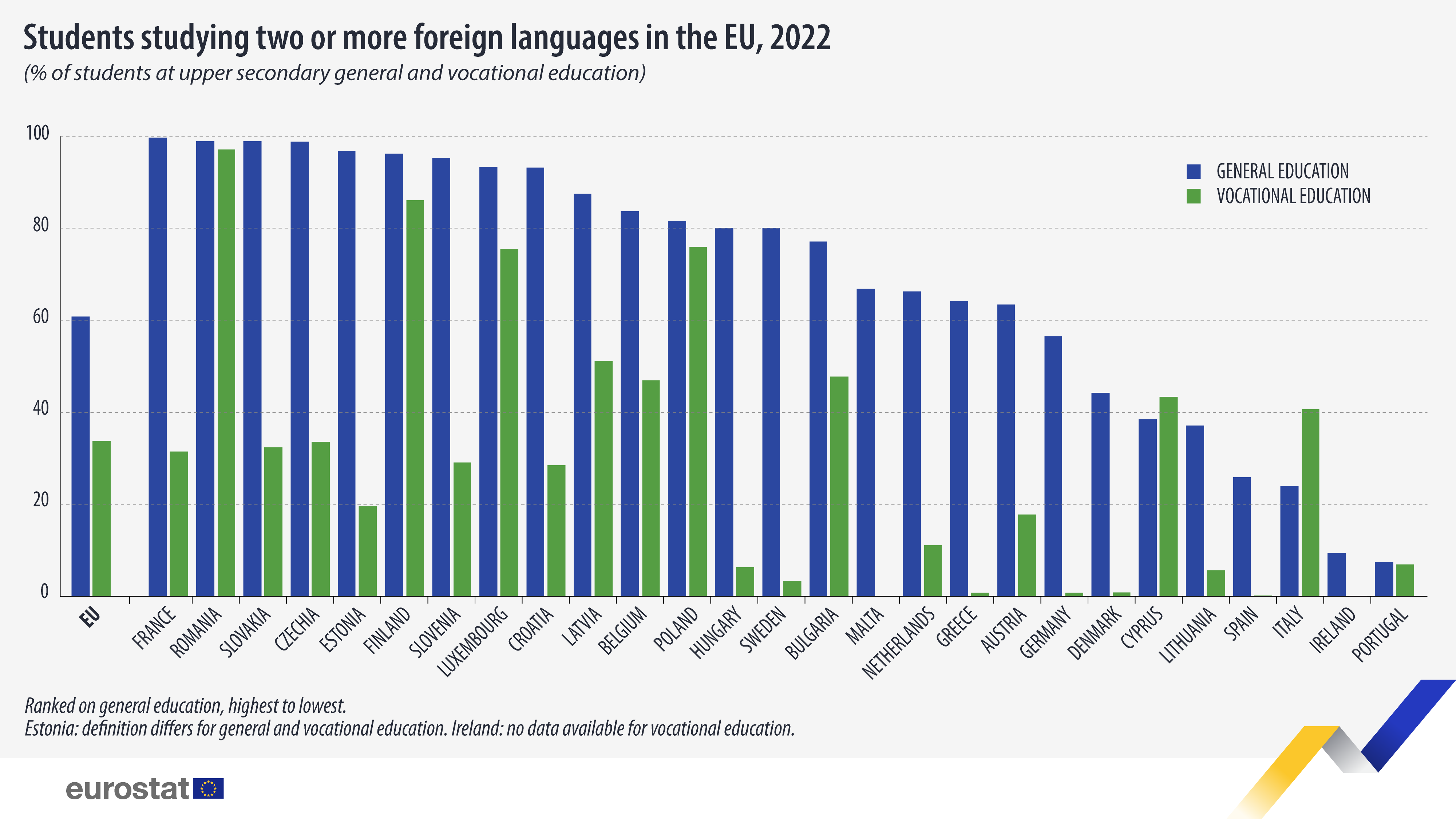Foreign languages in upper secondary education in 2022

In 2022, 60.8% of students in upper secondary general education across the EU studied 2 or more foreign languages as compulsory subjects or as compulsory curriculum options, a mere 0.2 percentage point decrease compared with 2021 (61.0%). In upper secondary vocational education, this share was 33.8%, marking a 1.1 percentage point decrease compared with 2021 (34.9%).
In 9 EU countries, more than 90% of upper secondary general education students studied 2 or more foreign languages. This is the case for nearly all students in upper secondary general education in France (99.7%), Romania and Slovakia (both 98.9%), and Czechia (98.8%).
In contrast, Portugal (7.5%), Ireland (9.4%) and Italy (24%) recorded the lowest shares of students studying 2 or more foreign languages.
Source dataset: educ_uoe_lang02
When it comes to upper secondary vocational education, Romania was the only EU country where almost all students (97.1%) studied 2 or more foreign languages in 2022, followed by Finland (86.1%), Poland (75.9%) and Luxembourg (75.5%).
The lowest shares of students studying 2 or more foreign languages were observed among vocational education students in Malta (0.0%), Spain (0.2%) and Germany and Greece (0.8% each).
English: top foreign language in upper secondary education
In 2022, English was the most studied foreign language in general and vocational education at the upper secondary level in the EU, with 96.3% and 76.3% of students learning it, respectively.
In terms of general education, Spanish ranked second (27.1%), followed by French (21.9%), German (21.4%) and Italian (3.2%). In addition, Russian was the non-EU language most commonly studied in the EU (2.7%).
In vocational education, the German language came in second (17.2%), followed by French (15.2%), Spanish (6.8%) and Russian (2.2%).
Source dataset: educ_uoe_lang01
For more information
- Statistics Explained set of articles on Education and training in the EU - facts and figures
- Thematic section on education and training
- Database on education and training
- Metadata on education and training
Methodological notes
- Upper secondary general education refers to the International Standard Classification of Education (ISCED) level 34, while upper secondary vocational education refers to ISCED level 35.
- Only foreign languages studied as compulsory subjects or as compulsory curriculum options are included. The study of languages when the subject is offered in addition to the minimum curriculum is excluded.
- The data refer to all modern spoken living languages that are taught as foreign languages. The learning of classical languages such as Ancient Greek and Latin is not included though they are the source of many modern languages and therefore can facilitate language learning in general.
- Belgium: the official state languages are Dutch, French and German.
- Luxembourg: French and German are both official languages and are taught as foreign languages. Finland: depending on their mother tongue, students have to choose between Finnish and Swedish as a foreign language. Both are considered foreign languages for the purpose of education statistics, but only when they are studied as a second language.
- Relevant updated information on the joint UIS (UNESCO Institute of Statistics)/OECD/Eurostat (UOE) data collection and quality reports compiled at the country level can be found in the Education administrative metadata file. Quality reports include an annex on Provisions for language learning.
- Estonia: definition differs both for general and vocational education.
- Ireland: no data available for all languages in vocational upper secondary education.
- Netherlands: no breakdown available for Italian in general upper secondary; no breakdown available for Spanish, French and Russian in vocational upper secondary.
If you have any queries, please visit our contact us page.


